

Red Hat OpenShift Streaming. SOLID Principles every Developer Should Know. Official Grafana docker image on OpenShift — widerin.net. Running offical docker images from docker hub on OpenShift Origin can be painful as it uses arbitrary user ids by default.
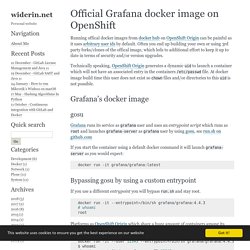
Often you end up building your own or using 3rd party forks/clones of the offical image, which leds to additional effort to keep it up to date in terms of security and/or version upgrades. Technically speaking, OpenShift Origin generates a dynamic uid to launch a container which will not have an associated entry in the containers /etc/passwd file. At docker image build time this user does not exist so chown files and/or directories to this uid is not possible. Grafana’s docker image. Application monitoring in OpenShift with Prometheus and Grafana - ConSol Labs. How to gather and display metrics in Red Hat OpenShift.
This post will show how to gather Apache Spark Metrics with Prometheus and display the metrics with Grafana in OpenShift 3.9.
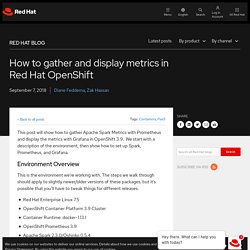
We start with a description of the environment, then show how to set up Spark, Prometheus, and Grafana. Environment Overview This is the environment we’re working with. The steps we walk through should apply to slightly newer/older versions of these packages, but it’s possible that you’ll have to tweak things for different releases. Origin/examples/grafana at master · openshift/origin. Package origin-clients - man pages. Package origin-clients - man pages. OpenShift - Who has a Kubernetes problem? OpenShift - Who has a Kubernetes problem? Features/OpenShift Origin - Fedora Project Wiki. Summary OpenShift Origin is a cloud application platform as a service (PaaS).
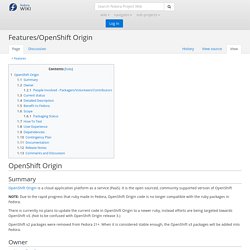
It is the open sourced, community supported version of OpenShift NOTE: Due to the rapid progress that ruby made in Fedora, OpenShift Origin code is no longer compatible with the ruby packages in Fedora. Thailand’s Ascend Money finds agility with OpenShift. OpenShift/Kubernetes tutorial - Infinispan. This tutorial needs to be executed in either OpenShift or Kubernetes.

For more information refer to READ.ME file. When oc or kubectl clients are initialized, invoke mvn clean install fabric8:run to run this tutorial. Openshift limits explained. Openshift is a Paas platform offered by Red Hat based mainly on Docker and Kubernetes.
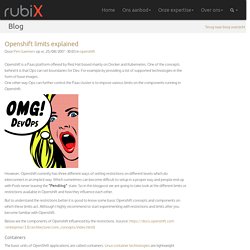
One of the concepts behind it is that Ops can set boundaries for Dev. For example by providing a list of supported technologies in the form of base images. One other way Ops can further control the Paas cluster is to impose various limits on the components running in Openshift. However, Openshift currently has three different ways of setting restrictions on different levels which do interconnect in an implicit way. Which sometimes can become difficult to setup in a proper way and people end up with Pods never leaving the “Pending” state. How Red Hat and OpenShift navigate a hybrid cloud world. The sky may be the limit for cloud computing, but it still helps to have an idea of how to get there.

“The vision is simple,” says Red Hat’s Mark McLoughlin. “It’s about ensuring that the majority of new software will be built on platforms which empower application developers and operators.” In other words, McLoughlin and Red Hat want to ensure that there are solid alternatives to the dominant infrastructure providers we see now, including Google Cloud, Amazon AWS and Microsoft Azure. A healthy competitive market is key to future innovation.
The senior director of engineering provided three ways to make the market thrive: “increase the threat” of new entrants by providing software that empowers them to utilize the public cloud market; increase the trade of substitutes by providing an alternative source of infrastructure for the public cloud and make it commonplace for buyers to switch between providers to give them strong negotiating power. .openshift · master · Mike Macgirvin / osada. Osada Switch branch/tag.
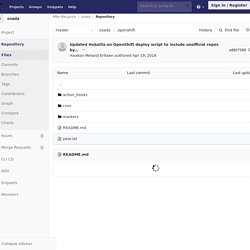
How Red Hat and OpenShift navigate a hybrid cloud world. Install OpenShift Origin on Ubuntu 18.04 – Mahesh Acharya. There are a lot of blogs and resources you will find online about installing OpenShift Origin, but none worked as advertised for me personally, thus, I am writing this as one more resource — which is working as of the day this is posted, to provide step by step guide on how to install OpenShift Origin on Ubuntu 18.04 Specifications Host VM — Ubuntu 18.04 on AWSOpenShift Origin Version : 3.9.0Docker version: 18.06.1-ce.
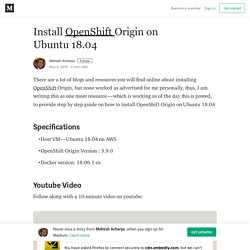
10 most important differences between OpenShift and Kubernetes cloudowski.com. UPDATED on 10.6.2019 (after the release of OpenShift 4.1): Added information on OpenShift 4.
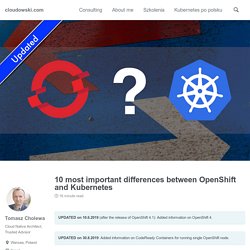
UPDATED on 30.8.2019: Added information on CodeReady Containers for running single OpenShift node. If you’re interested in OpenShift 4 please check out also my honest review of it. OpenShift has been often called as “Enterprise Kubernetes” by its vendor - Red Hat. In this article, I’m describing real differences between OpenShift and Kubernetes. It’s often confusing, as Red Hat tends to describe it as PaaS, sometimes hiding the fact that Kubernetes is an integral part of OpenShift with more features built around it.
Kubernetes is an open source project (or even a framework), while OpenShift is a product that comes in many variants. There are a couple of them: Red Hat OpenShift Container Platform This solution introduces Red Hat OpenShift Container Platform and the benefits of running OpenShift on Google Cloud Platform (GCP), such as: OpenShift enables running and supporting stateful and stateless apps without needing to completely re-architect your app.OpenShift uses the Red Hat Enterprise Linux operating system as its foundation, providing a stable and secure foundation for your apps.OpenShift natively integrates technologies such as Docker and Google Kubernetes Engine (GKE), a powerful cluster manager and orchestration system for running your Docker containers.
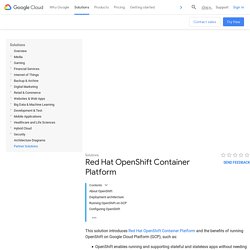
About OpenShift OpenShift equips you with an enterprise-grade Kubernetes environment, and all the tools and services you need to create, edit, deploy, and manage container-based apps at scale across a hybrid-cloud environment. The service integrates the architecture, processes, platforms, and services that empower development and operations teams to build apps that move your business forward. Deployment architecture. DO081x Courseware. Cloud Native Java EE on OpenShift : Adam Bien's Weblog. In the free, 3-part "Cloud-native Java EE" video series, I'm covering Java microservices, containers, openshift, WildFly full, container packaging, S2I, Java EE, patterns, errorhandling, scaling, packaging, configuration, deployment, with nothing but ThinWARs.
Lightning fast deployments included. Series preview (all episodes): The code is simple enough, so no slides were necessary to illustrate the ideas. See you at Web, MicroProfile and Java EE Workshops at Munich Airport, Terminal 2 or Virtual Dedicated Workshops / consulting. OpenShift 101: a short intro by Exoscale. OpenShift is to Kubernetes similar to what a Linux distribution is to the kernel. The world is talking about the Kubernetes Project - but did you hear about OpenShift? It’s an open source product based on the open source projects Kubernetes and Docker plus a container builder/registry, and a Web GUI to manage it all. NFT in Private Cloud Case Study.
Cognizant.kpoint. AWS Overview by Mahesh Kara 415872. aPaaS RedHat OSEv3 Concepts&PerformanceTesting. OSEV2&V3. Networking services security best practices. To secure OpenStack Networking, you must understand how the workflow process for tenant instance creation needs to be mapped to security domains. There are four main services that interact with OpenStack Networking. In a typical OpenStack deployment these services map to the following security domains: OpenStack dashboard: Public and managementOpenStack Identity: ManagementOpenStack compute node: Management and guestOpenStack network node: Management, guest, and possibly public depending upon neutron-plugin in use.SDN services node: Management, guest and possibly public depending upon product used.
To isolate sensitive data communication between the OpenStack Networking services and other OpenStack core services, configure these communication channels to only allow communication over an isolated management network. Restrict bind address of the API server: neutron-server # Address to bind the API serverbind_host = IP ADDRESS OF SERVER # Port the bind the API server tobind_port = 9696.
Architecting your first OpenStack cloud. OpenStack is the most popular open-source cloud computing platform to build and manage infrastructure-as-a-service (IaaS) environments. Since its inception in 2010 by Rackspace Hosting and NASA this project has gained popularity and positioned itself as a reliable alternative to proprietary IaaS platforms.
Now under the management of the OpenStack Foundation and with more than 30,000 Individual Members from over 170 countries around the world, OpenStack is thriving and increasing its presence in enterprise IT environments. In this article, I will be sharing best practices for the adoption of OpenStack as your IaaS platform and the necessary steps to take while building your cloud. In my experience, thorough planning is an essential ingredient for a successful cloud initiative. Identify your Business Objectives Adoption in an enterprise implies an investment of people and money. Enterprise cloud computing technology has fueled digital transformation. Untitled. Content.pivotal. At the end of the year there's no end of predictions from the IT analyst would.
In this episode, Richard and I talk with Pivotal's head analyst relations, Rita Manachi. We cover predictions in software development, infrastructure and cloud, and handful of miscellaneous ones like AI. Just for funsies, each of us throws in a prediction as well, plus a bonus book recommendation to start the new year with. DevOps & machine learning improves app performance! Programming & DevOps news, tutorials & tools. Red Hat Helps Power Tata Communications’ IZO™ Private Cloud with OpenShift and OpenStack.
VANCOUVER - OPENSTACK SUMMIT VANCOUVER 2018 — May 22, 2018 — Red Hat, Inc. (NYSE:RHT), the world’s leading provider of open source solutions today announced that Tata Communications, a global digital infrastructure provider, has selected Red Hat Cloud Suite, Red Hat’s broadest hybrid cloud offering, to help enhance its IZO™ Private Cloud service. ISVs in APAC Showcase Increased Red Hat OpenShift Adoption Across Verticals, Business News. ISV solutions help customers improve speed and flexibility to better meet ever changing business demands BALI, Indonesia, July 11, 2018 /PRNewswire/ -- Red Hat Partner Conference Asia Pacific -- Red Hat, Inc.
(NYSE: RHT), the world's leading provider of open source solutions, today showcased the uptake of Red Hat OpenShift Container Platform in Asia Pacific by many of the region's leading independent software vendors (ISV). ISVs such as BoCloud (China), UEC Group Ltd. (China), Yusys Technologies Co.
Red Hat OpenShift Container Platform 3.10 is now available. Today, we’re pleased to announce the general availability of Red Hat OpenShift Container Platform 3.10 (read the release notes; download the new version). Every release of OpenShift contains hundreds of fixes for enhanced security and performance, tested integrations throughout the stack, and access to hundreds of validated ISV solutions. For a full walkthrough of the latest updates, you can view our latest OpenShift Commons Briefing. Strengthening capabilities for intelligent, compute-intensive applications In this release, we’ve built on prior work and strengthened our capabilities for running computationally intensive workloads such as artificial intelligence, machine learning, animation, and financial services and payments applications.
Red Hat OpenShift Container Platform 3.10 is now available. An Open Source Load Balancer for OpenShift. Introduction. BOLT on Openshift: Automating A Continuous Testing Pipeline. Today’s marketplace is evolving at an even faster pace than yesterday’s. Teams are under pressure to evolve and adapt. More Speed, More Quality, More Features. //arctiq workshops. OpenShift and Network Security Zones: Coexistence Approaches. Introduction Kubernetes and consequently OpenShift adopt a flat Software Defined Network (SDN) model, which means that all pods in the SDN are in the same logical network. Google goes OpenShift. Is this Diane Greene's first deliverable?
PaaS shoot-out: Cloud Foundry vs. OpenShift. Installing OpenShift 3.7.1 in Under 30 Minutes. How to deploy Openshift on AWS. CFME: Login. iLearning PLUS - Search Catalogue. Highspot. Red Hat OpenShift Application Runtimes Download. Red Hat Releases OpenShift Application Runtimes. News. Red Hat partners with AWS with OpenShift Container Platform 3.7. This device is unable to play the requested video. Video: How to manage a multiple public cloud strategy Kubernetes has become the cloud container orchestration program.
Red Hat partners with AWS with OpenShift Container Platform 3.7. OpenShift on Public & Private Clouds with Amazon, Google, Microsoft, and Red Hat. Openshift. Yammer. Cognizant.kpoint.